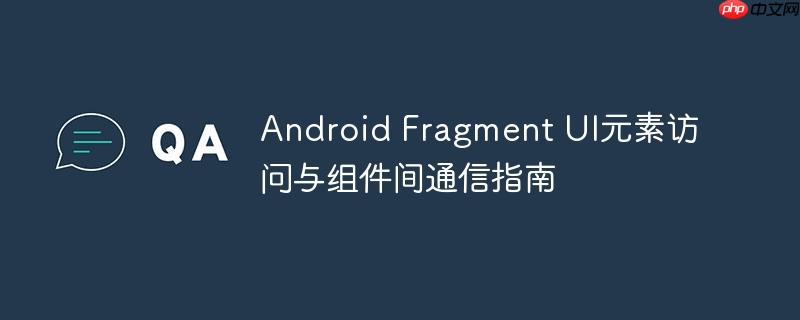
在android应用开发中,fragment是activity的模块化组成部分,拥有独立的生命周期和视图层次结构。当一个activity(例如secondpage)承载多个fragment(例如通过viewpager2和tablayout),并试图直接通过findviewbyid(r.id.fbtn)从activity的布局中查找fragment内部的ui元素时,通常会遇到nullpointerexception。这是因为findviewbyid方法默认会在当前activity的布局层次中进行查找。fragment的布局是独立于activity布局进行充气(inflating)的,因此activity无法“看到”fragment内部的视图id。
具体来说,当SecondPage Activity的onCreate方法执行时,它只会加载activity_second_page.xml布局。而fbtn按钮位于fragment_basic.xml中,该布局是在Basic Fragment的onCreateView方法中被充气的。在SecondPage的onCreate阶段,Basic Fragment可能尚未完全创建其视图,或者即使创建了,其视图层次也未合并到Activity的根视图中,导致findViewById返回null。
访问Fragment内部的UI元素(如Button、TextView等)应在Fragment自身内部进行。最合适的时机是Fragment的onViewCreated生命周期回调方法中。在该方法中,Fragment的视图已经被创建并充气完成,可以通过Fragment的根视图来查找子视图。
示例代码:在Fragment中获取Button
import android.os.Bundle;
import androidx.annotation.NonNull;
import androidx.annotation.Nullable;
import androidx.fragment.app.Fragment;
import android.view.LayoutInflater;
import android.view.View;
import android.view.ViewGroup;
import android.widget.Button;
import android.widget.Toast;
public class BasicFragment extends Fragment { // 建议Fragment类名以Fragment结尾
private Button fragmentButton; // 声明Fragment内部的UI元素
@Override
public View onCreateView(LayoutInflater inflater, ViewGroup container,
Bundle savedInstanceState) {
// 充气Fragment的布局
return inflater.inflate(R.layout.fragment_basic, container, false);
}
@Override
public void onViewCreated(@NonNull View view, @Nullable Bundle savedInstanceState) {
super.onViewCreated(view, savedInstanceState);
// 在onViewCreated中,Fragment的视图已创建,可以通过传入的view参数查找UI元素
fragmentButton = view.findViewById(R.id.fbtn); // 假设fbtn是fragment_basic.xml中的按钮ID
if (fragmentButton != null) {
fragmentButton.setOnClickListener(v -> {
// 在Fragment内部处理按钮点击事件
Toast.makeText(getContext(), "Fragment Button Clicked!", Toast.LENGTH_SHORT).show();
// 如果需要跳转Activity,可以在这里调用getActivity().startActivity(...)
// 例如:Intent intent = new Intent(getActivity(), AnotherActivity.class);
// getActivity().startActivity(intent);
});
}
}
}在上述代码中,fragmentButton是在onViewCreated方法中通过view.findViewById()获取的,这里的view是onCreateView返回的Fragment根视图。这样可以确保在视图存在时才尝试查找并操作UI元素。
如果Activity需要与Fragment内部的UI元素交互,或者Fragment需要向Activity传递事件或数据,直接访问UI元素并非最佳实践。Android提供了多种推荐的组件间通信模式,以实现解耦和生命周期安全。
ViewModel是Android Jetpack组件的一部分,用于以生命周期感知的方式存储和管理UI相关数据。通过让Activity和Fragment共享同一个ViewModel实例,它们可以方便地交换数据和事件,而无需直接引用彼此。
步骤:
创建共享ViewModel: 定义一个继承自ViewModel的类,其中包含LiveData或其他可观察的数据持有者。
import androidx.lifecycle.LiveData;
import androidx.lifecycle.MutableLiveData;
import androidx.lifecycle.ViewModel;
public class SharedViewModel extends ViewModel {
private final MutableLiveData<String> selectedItem = new MutableLiveData<>();
private final MutableLiveData<Boolean> navigateEvent = new MutableLiveData<>();
public void selectItem(String item) {
selectedItem.setValue(item);
}
public LiveData<String> getSelectedItem() {
return selectedItem;
}
public void triggerNavigation() {
navigateEvent.setValue(true); // 使用事件包装器更佳,避免重复触发
}
public LiveData<Boolean> getNavigateEvent() {
return navigateEvent;
}
}在Activity和Fragment中获取ViewModel实例: 使用ViewModelProvider并传入相同的ViewModelStoreOwner(通常是Activity本身)来获取共享实例。
Activity (SecondPage) 中的使用:
import androidx.lifecycle.ViewModelProvider;
public class SecondPage extends AppCompatActivity {
// ... 其他成员变量
private SharedViewModel sharedViewModel;
@Override
protected void onCreate(Bundle savedInstanceState) {
super.onCreate(savedInstanceState);
setContentView(R.layout.activity_second_page);
// ... 初始化TabLayout和ViewPager2
// 获取共享ViewModel实例
sharedViewModel = new ViewModelProvider(this).get(SharedViewModel.class);
// 观察Fragment发出的导航事件
sharedViewModel.getNavigateEvent().observe(this, shouldNavigate -> {
if (shouldNavigate != null && shouldNavigate) {
// 处理导航逻辑,例如跳转到另一个Activity
// Intent intent = new Intent(this, AnotherActivity.class);
// startActivity(intent);
Toast.makeText(this, "Activity received navigation request from Fragment!", Toast.LENGTH_SHORT).show();
// 重置事件,避免旋转屏幕时重复触发
sharedViewModel.getNavigateEvent().setValue(false);
}
});
}
}Fragment (BasicFragment) 中的使用:
import androidx.lifecycle.ViewModelProvider;
public class BasicFragment extends Fragment {
private Button fragmentButton;
private SharedViewModel sharedViewModel;
// ... onCreateView 方法
@Override
public void onViewCreated(@NonNull View view, @Nullable Bundle savedInstanceState) {
super.onViewCreated(view, savedInstanceState);
fragmentButton = view.findViewById(R.id.fbtn);
// 获取共享ViewModel实例,传入getActivity()作为ViewModelStoreOwner
sharedViewModel = new ViewModelProvider(requireActivity()).get(SharedViewModel.class);
if (fragmentButton != null) {
fragmentButton.setOnClickListener(v -> {
// Fragment通过ViewModel通知Activity执行导航
sharedViewModel.triggerNavigation();
});
}
}
}接口回调是一种经典的通信模式,适用于Fragment需要将事件传递给其宿主Activity的场景。
步骤:
定义接口: 在Fragment内部定义一个公共接口,包含Fragment希望Activity实现的事件方法。
public class BasicFragment extends Fragment {
// 1. 定义接口
public interface OnFragmentInteractionListener {
void onFragmentButtonClick();
// void onDataPassed(String data); // 如果需要传递数据
}
private OnFragmentInteractionListener listener;
private Button fragmentButton;
// ... onCreateView 方法
@Override
public void onAttach(@NonNull Context context) {
super.onAttach(context);
// 2. 在onAttach中检查宿主Activity是否实现了接口
if (context instanceof OnFragmentInteractionListener) {
listener = (OnFragmentInteractionListener) context;
} else {
throw new RuntimeException(context.toString()
+ " must implement OnFragmentInteractionListener");
}
}
@Override
public void onViewCreated(@NonNull View view, @Nullable Bundle savedInstanceState) {
super.onViewCreated(view, savedInstanceState);
fragmentButton = view.findViewById(R.id.fbtn);
if (fragmentButton != null) {
fragmentButton.setOnClickListener(v -> {
// 3. 按钮点击时调用接口方法,通知Activity
if (listener != null) {
listener.onFragmentButtonClick();
}
});
}
}
@Override
public void onDetach() {
super.onDetach();
// 4. 在onDetach中解除引用,避免内存泄漏
listener = null;
}
}Activity实现接口: 宿主Activity实现该接口,并提供接口方法的具体实现。
public class SecondPage extends AppCompatActivity implements BasicFragment.OnFragmentInteractionListener {
// ... 其他成员变量
@Override
protected void onCreate(Bundle savedInstanceState) {
super.onCreate(savedInstanceState);
setContentView(R.layout.activity_second_page);
// ... 初始化TabLayout和ViewPager2
}
// 5. 实现Fragment定义的接口方法
@Override
public void onFragmentButtonClick() {
// 在Activity中处理Fragment按钮点击事件
Toast.makeText(this, "Activity received button click from Fragment via interface!", Toast.LENGTH_SHORT).show();
// 例如:Intent intent = new Intent(this, AnotherActivity.class);
// startActivity(intent);
}
}在Android开发中,正确处理Fragment内部UI元素的访问以及Fragment与Activity之间的通信至关重要。直接在Activity中通过findViewById查找Fragment内部UI是错误的,应在Fragment的onViewCreated方法中进行。对于组件间通信,推荐使用共享ViewModel实现生命周期安全的数据共享和事件传递,或采用接口回调机制进行事件通知。选择合适的通信模式,可以帮助开发者构建更健壮、更易于维护的Android应用程序。
以上就是Android Fragment UI元素访问与组件间通信指南的详细内容,更多请关注php中文网其它相关文章!

每个人都需要一台速度更快、更稳定的 PC。随着时间的推移,垃圾文件、旧注册表数据和不必要的后台进程会占用资源并降低性能。幸运的是,许多工具可以让 Windows 保持平稳运行。

Copyright 2014-2025 https://www.php.cn/ All Rights Reserved | php.cn | 湘ICP备2023035733号